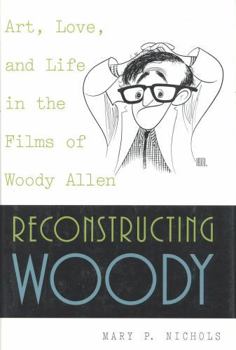Reconstructing Woody: Art, Love, and Life in the Films of Woody Allen
Select Format
Select Condition 
Book Overview
For too long, the films of Woody Allen have been interpreted as expressions of deconstructionism, nihilism, and postmodern angst. In this pathbreaking new book, Mary P. Nichols challenges this, arguing that Allen's work, from Play It Again, Sam to Deconstructing Harry, is actually an attempt to explore and reconcile the tension between art and life. As witty and complex as its subject, Reconstructing Woody shows that Allen is immensely concerned with...
Format:Paperback
Language:English
ISBN:0847689905
ISBN13:9780847689903
Release Date:September 2000
Publisher:Rowman & Littlefield Publishers
Length:270 Pages
Weight:0.75 lbs.
Dimensions:0.7" x 5.9" x 9.0"
Related Subjects
Arts & Literature Arts, Music & Photography Biographical Biographies Biographies & History Biography & History Direction & Production Entertainers Film & Television Humor & Entertainment Movie Directors Movies Performing Arts Political Science Politics & Social Sciences Social SciencesCustomer Reviews
3 ratings
Thesis
Published by Thriftbooks.com User , 23 years ago
Nichols has basically written the equivalent of a term paper on the films and life of Woody Allen. That is not to say that the book is dull or only a collection of non-emotive facts about Allen. It delves deep to examine the many facets of his life and the films that he has created. For anyone who really appreciates Woody Allen's films, this would be the book for you.
The Best Woody Ever
Published by Thriftbooks.com User , 24 years ago
Nichols has made an exemplary contribution to film studies by integrating that mushy discipline with the rigor of political philosophy. She's surely smarter and better than Woody, but with her help we can see what is best about his art as moral and philosophical illumination.
A profound and provocative meditation on life and art.
Published by Thriftbooks.com User , 25 years ago
Professor Mary Nichols's "Reconstructing Woody" is a profound and provocative meditation on life and art that gazes at these issues through the lens of Woody Allen's films. Nichols's treatment is unique for its insight and readability. Moreover, she succeeds in establishing three truths in her book: 1. That film is as complex, philosophic and insightful a medium for reflecting upon life as any other literary genre, combining especially the novel's ability to recreate a detailed world and drama's ability to have visual impact. 2. That the literary/dramatic reflection of life in art is not simply "reflective" or "passive," but instead represents the artist's ability to see the world through "a" world. If that artist is thoughtful and talented enough, then we do ourselves a service by trying to enter into his or her lens to view our own world. Nichols persuasively demonstrates that Allen is an artist of that rank. 3. That (and this is a very old issue in the Western world) the "sophisticated criticism" of certain intellectuals may, in fact, be less profound than the art it tries to explain. Allen himself has clearly and funnily portrayed this in his films, and Nichols, by presuming that Allen has something to teach her and us, has produced an intellectual commentary that does not distort or render shallow his dramatic corpus. In short, in confronting Allen's art through Nichols's book, the reader will emerge with a greater ability to appreciate a worthy artist's work and the world that that work represents.





